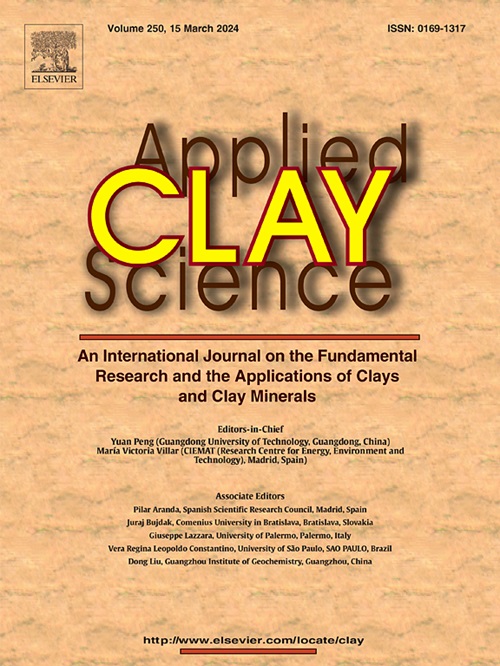不同瓷土和球粘土对传统陶瓷工艺的影响:多方法论方法
IF 5.3
2区 地球科学
Q2 CHEMISTRY, PHYSICAL
引用次数: 0
摘要
通过将技术特性、矿物学成分和三维成像相结合,可以深入了解中国玻璃工艺的卫生洁具陶瓷坯体与配制滑料时所使用的不同粘土原料之间的关系。首先,中国粘土和球粘土的不同组合会导致不同的铸造行为,然后,由于粒度分布的变化而不是矿物成分的变化,会导致不同的机械强度。特别是,粒度越细,孔径越细,此外,由于更好的填料,机械性能越好(最大为 4.7 兆帕)。在烧制过程中,这种差异会因为坯体致密化而得到缓解,并产生更相似的孔隙分布,但矿物成分的重要性也会显现出来。事实上,矿物相含量和高岭石 HI 指数的差异有助于理解高温相演变和技术特性,如烧成体的热膨胀,主要是通过残留石英。本文章由计算机程序翻译,如有差异,请以英文原文为准。
Effects of different China and ball clays on traditional ceramic process: A multi-methodological approach
A combination of technological properties, mineralogical composition and three-dimension (3D) imaging is proposed to get insights into sanitary-ware ceramic bodies of the Vitreous-China technology as a function of the different clay raw materials used in the formulation of slip. Particular attention is paid to the effects induced along the production chain, during casting, after drying (dried body) and after firing (fired body).
The different combinations of China and ball clays lead to different casting behaviour, in first instance, and to different mechanical strength, then, due to variations in the particle size distribution rather than in the mineralogical composition. In particular, the finer the particle size, the finer the pore size and, in addition, the better the mechanical properties (with a maximum of 4.7 MPa), due to a better packing. However, fine particle size distribution worsens the slip's behaviour into moulds, impacting negatively on productivity, with a 17 % reduction of casting thickness.
Upon firing process, such differences are mitigated by the body densification and result in more similar pores' distributions, though the importance of the mineralogical composition is revealed. In fact, differences in mineralogical phases' contents and in kaolinite HI index guide the comprehension of high temperature phase evolution and technological properties like the fired body thermal expansion, foremost via residual quartz.
These results are important for a plastic raw materials's selection within the ceramic sanitary-ware process.
求助全文
通过发布文献求助,成功后即可免费获取论文全文。
去求助
来源期刊

Applied Clay Science
地学-矿物学
CiteScore
10.30
自引率
10.70%
发文量
289
审稿时长
39 days
期刊介绍:
Applied Clay Science aims to be an international journal attracting high quality scientific papers on clays and clay minerals, including research papers, reviews, and technical notes. The journal covers typical subjects of Fundamental and Applied Clay Science such as:
• Synthesis and purification
• Structural, crystallographic and mineralogical properties of clays and clay minerals
• Thermal properties of clays and clay minerals
• Physico-chemical properties including i) surface and interface properties; ii) thermodynamic properties; iii) mechanical properties
• Interaction with water, with polar and apolar molecules
• Colloidal properties and rheology
• Adsorption, Intercalation, Ionic exchange
• Genesis and deposits of clay minerals
• Geology and geochemistry of clays
• Modification of clays and clay minerals properties by thermal and physical treatments
• Modification by chemical treatments with organic and inorganic molecules(organoclays, pillared clays)
• Modification by biological microorganisms. etc...
 求助内容:
求助内容: 应助结果提醒方式:
应助结果提醒方式:


